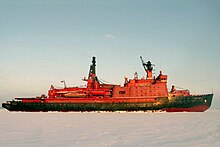Baltic plant

Baltic Factory ( Балтийский завод , Baltiski sawod) is the name of a mechanical engineering and shipbuilding company in Saint Petersburg , Russia . It was founded in 1856 as a shipyard by Marc MacPherson ( Марк Львович Макфердсон ), born in Scotland in 1804, and the Petersburg businessman Matvej Egorowitsch Carr ( Матвей Егорович Карр ). The company, renamed the Baltic Works since 1923, is part of the United Shipbuilding Corporation and is now mainly engaged in the construction of merchant ships .
1856-1874: Carr and MacPherson
MacPherson worked as an engineer on the imperial yacht Newka until 1853 . He also ran a mechanical workshop in St. Petersburg. In 1856 he proposed to Carr to found a company that included a foundry and a mechanical workshop as well as a shipyard. The plants were set up in the southwestern part of Vasilyevsky Island in St. Petersburg. MacPherson, who died in 1879, was director and chief engineer of the company until 1872.
Under the aegis of Carr and MacPherson , the first Russian armored warship, the Opyt gunboat, was built in 1861 , and the first Russian submarine in 1866 . In the period that followed, the shipyard was involved in the construction of several warships for the Imperial Russian Navy and, in addition to the Admiralty Shipyards, one of the carriers of the Russian naval armor. For example, Carr and MacPherson built two Uragan-class gunboats and the Admiral Lazarew armored frigate . In addition to ships, steam engines and equipment for the Russian fleet were also supplied. In 1874 the company ran into economic difficulties and was sold to the Russian Prince Ochtomski .
From 1923 Baltic plant
After the Great October Socialist Revolution , the shipyard was expropriated and initially designated as Plant No. 189. On November 7, 1922, the shipyard was renamed after the French communist André Marty . After the October Revolution there were serious problems due to low capacity utilization, but the 245 employees registered at that time decided on June 5, 1923 to maintain the plant, which was now called the Baltic Works .
One of the company's products from this time was, for example, the diesel-electric locomotive SŽD series Щэл1 from 1924. From 1975 to 2007, among other things, nine nuclear icebreakers were built at the shipyard.
Web links
- Company website, English version
- Russian preparations for war , published in: Nelson Examiner and New Zealand Chronicle, 1864 (English)
literature
- Norman Polmar: The Naval Institute guide to the Soviet Navy . United States Naval Institute, 1991, ISBN 978-0-87021-241-3 (English).


